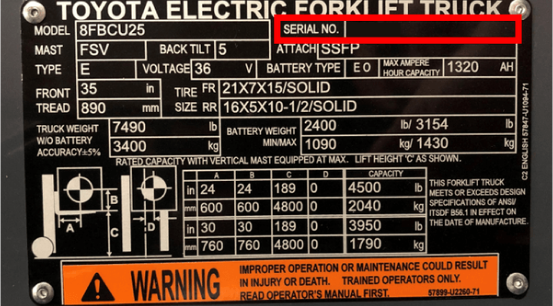How to Find Your Equipment Model Number
Finding the right parts for your equipment is easy when you have your model and serial number which can be found on the data plate. Luckily, a forklift data plate is installed on every truck on the market to help you understand what your forklift can do and provide vital information.
Model Number: The model number of your toyota forklift is extremely important for relaying information to your dealers about repair or technical assistance and for looking up replacements part!
Serial Number: The serial number on your lift is the most important number.The model serial number combination will allow us to provide you with the parts that will fit your particular piece of equipment.

How to Find Your Equipment Serial Number
Finding the right parts for your equipment is easy when you have your model and serial number which can be found on the data plate. Luckily, a forklift data plate is installed on every truck on the market to help you understand what your forklift can do and provide vital information.
Model Number: The model number of your toyota forklift is extremely important for relaying information to your dealers about repair or technical assistance and for looking up replacements part!
Serial Number: The serial number on your lift is the most important number.The model serial number combination will allow us to provide you with the parts that will fit your particular piece of equipment.

Need some help? For further assistance or more information, contact your local Toyota Dealer.

Please click below to sign in to your MyToyota account
Don't have an account?
Mast Chains: Purpose And Maintenance

There are a lot of moving parts on a forklift that are critical to its operation and the mast chains are no exception. As you may already know, a forklift uses hydraulic pressure to raise the mast up by raising the lift cylinders. This, in turn, raises the inner mast channels, but without the lift chains, your forks and carriage aren’t going anywhere. And if your forks aren’t being lifted, you aren’t going to be getting much work done.
So how does it all work? As I explained, the lift cylinders will lift the inner mast rails, but the mast chains are actually responsible for lifting the carriage and forks. Each mast chain is attached to the carriage and then routed up and over a chain wheel that acts as a pulley. The chain is then bolted into a boss that is welded onto the inner mast rail. So when the mast rails raise, the chains also raise, and thus the carriage goes up with it.
Mast Chain Wear And Inspection
As you can imagine, having to carry the bulk of your load weight during thousands of lift and lower cycles can take its toll. This wear will eventually cause the mast chains to elongate or even show other signs of disrepair depending on their age, use, and operating conditions. Since the chains are responsible for holding up the forklift’s carriage and ultimately a potentially large and heavy load, ignoring these warning signs could lead to product damage, injuries, or worse.
Your mast chains should be inspected at the start of every shift as part of your inspection of the forklift’s lift/lower systems. When inspecting the chains, be sure to look out for the following warning signs:
- Broken Links: Broken links can be caused by abnormal force on the chains whether from dropping a load or working on an uneven surface.
- Turned Pins: Lack of lubrication will cause pins to turn. If you see one turned pin, it’s likely there will be more. Always make sure the chains are properly lubricated prior to use.
- Wear or Elongation Over Three Percent**: Over time, forklift chains wear out. You’ll need a chain gauge to measure wear and elongation. If your chain has elongated over three percent, it’s time to replace it.
Be mindful that chain pitch can vary with different chain designs and different pitches have different limits for stretch or elongation. Most chain gages will have wear guides for multiple types and pitches, so be sure you are following the instructions based on your specific type.
If you’re ever in doubt, be sure to reach out to your local, authorized Toyota dealer for assistance with inspecting your forklifts. They can even schedule planned maintenance with you so that a technician can inspect your forklifts at pre-determined intervals for all of these issues and more.
** Any elongation of your forklift chain should be properly inspected by a qualified technician.